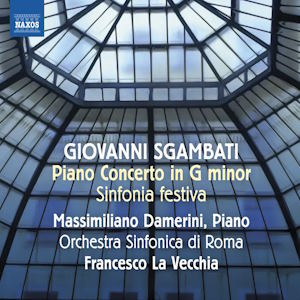
Giovanni Sgambati (1841–1914)
Sinfonia festiva (Ouverture de fête) (1878/1879)
Piano Concerto in G minor, op. 15 (1879/1880)
Massimiliano Damerini (piano)
Orchestra Sinfonica di Roma/Francesco La Vecchia
rec. 2012/13, Auditorium della Concilazione, Rome, Italy
Naxos 8.573272 [50]
A few words about Giovanni Sgambati may be useful. Crucially, he is one of the few nineteenth-century Italian composers who favoured instrumental music over operatic and vocal. He wrote two symphonies, a Messa da Requiem, a Te Deum Laudamus for choir, string orchestra and organ, several chamber pieces and many songs. His considerable contribution to solo piano literature includes etudes and nocturnes. He was a child prodigy. After mature study with Franz Liszt, he went on to become a highly regarded pianist, composer, teacher and conductor. He was active in promoting German music in Italy.
The Sinfonia festiva or Ouverture de fête immediately reminds one of Beethoven, especially parts of Symphony No. 7. The liner notes (from which I quote,with thanks) I admit that there is no background information on this work, “presumably” composed for the Società orchestrale romana around the same time as the Piano Concerto. It is called a festive overture, but it is not clear what event it celebrated. The structure is cleverly enigmatic: three main themes in various guises. Is the Overture written in sonata form? Perhaps it is a fantasy? Or does it nod towards being a rondo? Whatever the techniques, this lively, vibrant music fairly dances along. The world premiere recording showcases Sgambati’s skill and confidence. The piece deserves a place in the repertoire.
When I heard the Piano Concerto the first time, I was not convinced. For me, it failed, what with much darkness and little optimism. I was wrong. On my second play through, Sgambati’s talent and magic slowly began to reveal themselves. One of the problems may be the long, lugubrious orchestral introduction which does not seem to promise a lot. Yet, as the work develops, an outpouring of advanced pianism produces “many poetic touches, glistening figurations […] and unexpected flights of fancy”. The massive Moderato maestoso has several big cadenzas which balance the morose prologue, before reaching a hard-won conclusion. Respite comes in the shorter Romanza. As the liner notes suggest, it allows the soloist to draw breath before embarking on the rondo-sonata finale. This powerful, demanding movement has hints of Liszt’s Hungarian Rhapsodies and of saltarello, a mediaeval Roman dance. The concerto heroically puts together soloist and orchestra, sometimes as opponents, sometimes as partners.
If you like to indulge in “who does this sound like” games, I suggest nods to Schumann, Tchaikovsky and Liszt, especially in the finale. But the overall effect is a well-wrought equilibrium between classical and romantic styles which devolves to the influence of Johannes Brahms.
Other performances of the Piano Concerto – which I have not heard – include that by Francesco Caramiello with the Nürnberger Philharmoniker and Fabrizio Ventura (review), and a historical recording by Jorge Bolet with Nürnberger Symphoniker and Ainslee Cox (review). The former was first released in 2001 on ASV (CDDCA1097). The present disc was recorded some ten years ago; it too may be a re-release.
Tommaso Manera’s liner notes, in Italian with an English translation by Susannah Howe, give all the information one needs to enjoy this programme. Massimiliano Damerini and the Orchestra Sinfonica di Roma under Francesco La Vecchia play superbly. Never mind my doubt at first hearing, we have here an impressive performance of Sgambati’s Piano Concerto. (Sadly, Damerini died at 72 in July 2023.)
John France
Help us financially by purchasing from




















